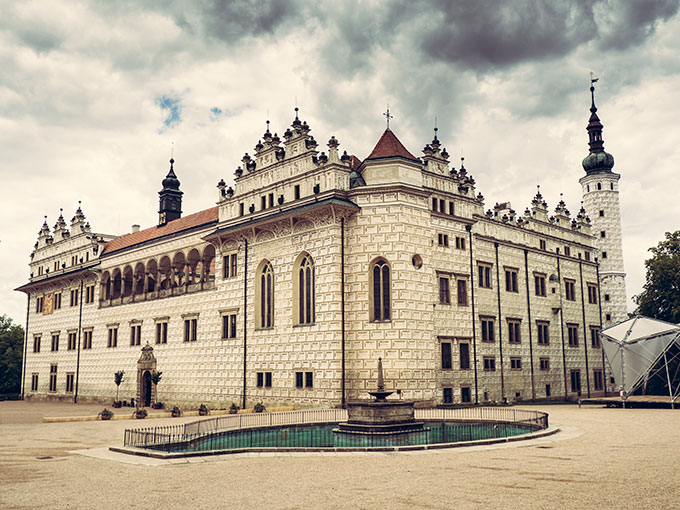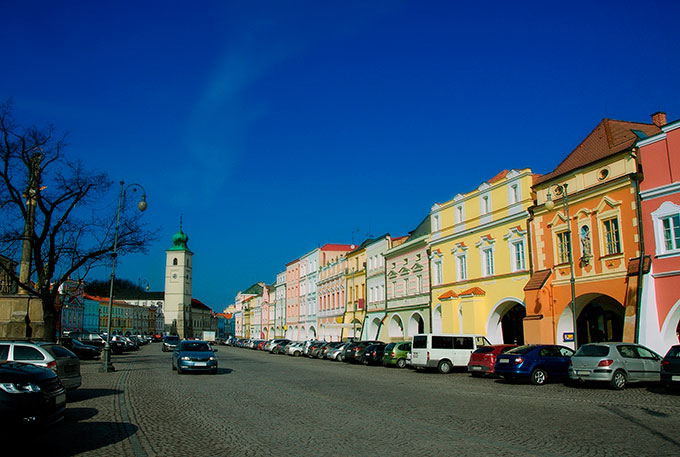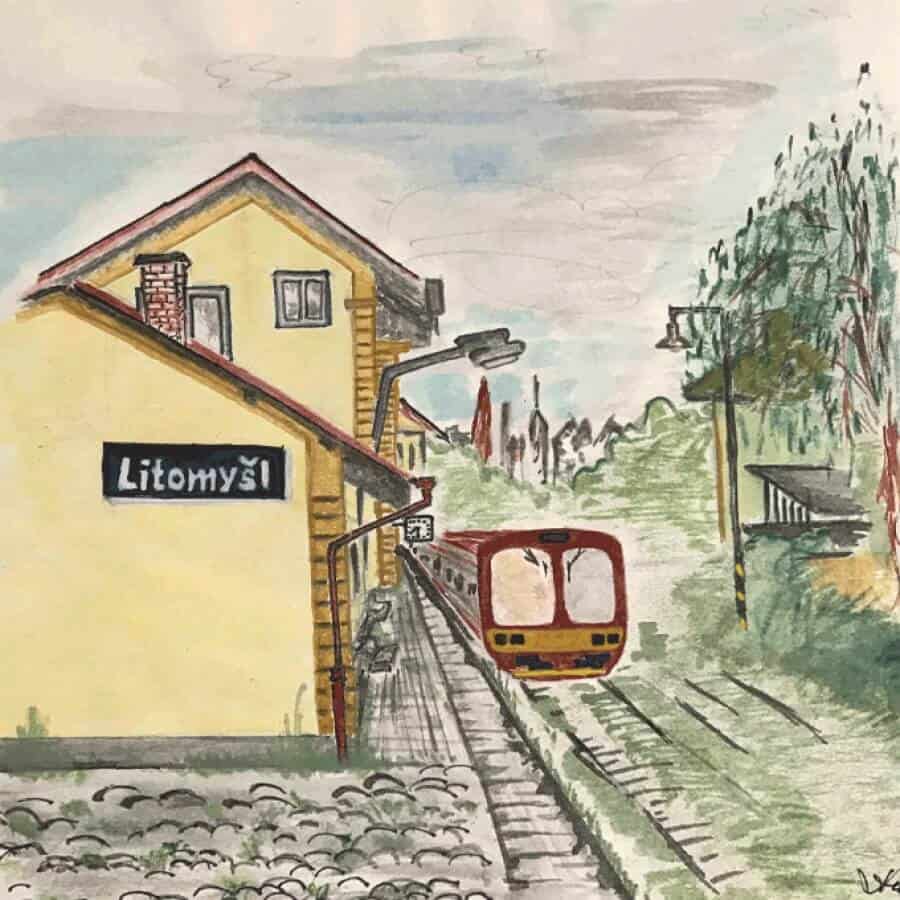It is a recipe which has been followed by all classical authors of world literature: if you want the Muse to pay you a visit, leave the noisy city behind and move to a quiet place, where life proceeds calmly and smoothly, without hustle and bustle – a place where the presence of people is so unobtrusive that you will think about it only if you happen to stumble upon a passer-by. A year ago, I discovered such place in the Czech Republic, and after paying it several visits, I have completely fallen in love with it.
According to historians, this place derives its name from the aggregation of two Czech words which are “litost” (translated as “repentance”) and “domyslivec” (arrogant, prideful person). That is how Litomysl came into existence: it seems that Prince Vitislav, the founder of the town, wanted to recant his previous sins – pride and haughtiness. We do not know, of course, whether he received absolution for his sins but, despite its relatively small size (in 2012, its population was slightly more than ten thousand people), the town has become one of the most prominent cultural centers in the Czech Republic.
On Faith and Fires
The Czech Republic is often regarded as a highly secular country when it comes to matters of faith and religion (according to the 2011 census, only a fifth part of the entire population consider themselves to be practicing any faith). By comparison, in 1991, the percentage of observant believers amounted to 43,9%, while in 1950 it was an enormous 93,9%). Nonetheless, the history of the small town of Litomysl has always been inextricably connected with religion. Litomysl was founded in 981 and was first mentioned in the Czech Chronicle, written by Kozma of Prague, along with the name of Prince Slavnik, the father of St. Vojtech, whose cultural merits were later praised in modern literature. Limomysl was mentioned for the second time in a document issued by King Wladyslaw I (1167) respecting a church which must have been erected there by Bretislav at the end of the 11th century. This church building later became the core of the Premostransky monastery, which was built in the city in the mid-40s of the 12th century. The bishopric of the same name, which was subordinate to the Prague episcopacy, opened its doors here almost a hundred years after King Otokar Premysl II granted the town official status. In his book “Litomysl”, the historian Milan Skrivanek provided a detailed explanation of the formation of the church structure as well as the changes that it went through. The development came to a halt during the Hussite wars, the canons having left the town and the episcopacy fading into history, although it was officially abolished only in 1554.
Apart from caring for the soul, the people of Litomysl did not forget about the need for daily bread. The town gradually filled up with tradespeople: bakers, weavers, and cloth-makers. Nevertheless, agriculture and farming still remained the most important component of the local economy. The workshops had to be restored every now and then: Litomysl, which mostly consisted of wooden buildings, suffered from fires which occurred almost every year; therefore, much of its original architecture has been lost. It seems that the department of restorers of the Pardubice University was founded here for a good reason: they always had plenty of work!

Castle Litomysl / Photo: Shutterstock
The Curse of a Wooden Dress
The recurring fires miraculously spared one of the town’s popular attractions, which is the castle-palace, a magnificent example of Renaissance architecture, covered with the special finish work called sgraffito. The main advantage of this exterior decoration technique is not only the beauty of the ornament itself, but also its durability. Sgraffito technique begins with covering the wall with two or three layers of colored plaster and then scratching the top layer in certain places to reach the necessary color. This method allows sgrafitto artists to preserve the original architectural concept of the building for a long time. However, it is a technique that forgives no mistakes; therefore, in order to prevent the plaster from “drifting”, sgrafitto craftsman always used stencils.
The credit for building the castle, which was finished in 1582, goes entirely to Count Vladislav of Perstein, who directly involved himself in the construction process. In 1999, the castle was placed on UNESCO’s World Heritage list.
As befits all castles, this one harbors a lot of ghosts.
According to legend, a nobleman was once allowed to spend the night in the castle. He woke up in the middle of the night after hearing a loud noise, and then a terrifying voice which said, “Secula seculurum!” The frightened nobleman gave the innocent servants a dressing down for the stupid joke and left. The owners of the castle closed the room and tried to avoid entering it under any circumstances. But once a wandering monk came to the castle and asked for permission to spend the night. There were no vacant rooms, except for the mysterious room. The servants honestly told the monk about the sepulchral voice, but the wondering monk didn’t seem to be scared and asked his hosts to prepare the bed. When a loud noise woke him up, the made the sign of the cross and asked the ghost whether he could be of assistance. The words in Latin sounded once again and the monk answered, “Amen”, into the darkness. And then he heard, “God bless you, I am free”. The monk spent the rest of the night in peace, and the ghost has never appeared in the castle again.
Another story and another ghost still put fear into the hearts of those who visit the castle today. Once upon a time, an arrogant and narcissistic countess lived in the castle; she loved to be different from everyone else, and she was also filthy rich. One day she felt particularly bored and ordered a dress made of bread. A suitable dress was made, and the countess decided to wear it for a walk around the park, where she met a beggar. The beggar asked for at least a lump of bread, but the noblewoman refused and shouted at the pauper to get out of her sight. But before the beggar went away, she cursed the rich woman. Back at the castle, the Countess fell through the floor into the dungeons, and the ground immediately closed over her. Some people say that her unforgiven soul is still wandering through the dungeons and scares anyone she meets.
Recipes for the soul and the stomach
The emergence of a new architectural gem in the town, along with a change to a new ruler, marked the beginning of a new era. After a period of time, Litomysl turned into a true cultural center: the court, or, to be more precise, the castle theater was flourishing, and literary learning was also given proper attention. Many prominent personalities from the Czech Republic have contributed to maintaining the appropriate image, among them Bedrich Smetana, a composer in whose honor the Litomysl festival of classical music was named. In 2018, this festival will be held for the 60th time. To be more precise, the festival was initially devoted only to classical music. But nowadays, apart from obligatory performances of “Mermaid”, the program also includes modern jazz musicians as well as improvisations. This year, a concert of the music of Arturo Sandoval was one of the most memorable parts. The composer played Afro-Cuban music, be-bop, romantic ballads, and classical works with equal ease. Arturo fell in love with music when he was ten years old while living in Cuba, where obtaining a musical instrument was a hard task. Arturo’s aunt gave him a horn, and the gift made his future possible.
Litomysl’s reputation is also supported by famous authors – for instance, Magdalena Rettigova, the Czech writer and activist, whose cookbook has been a culinary and linguistic self-help book for many German-speaking housewives in the Czech Republic (you can find the online recipes at www.recepty-rettigova.cz).
Or Bozena Nemcova, who spent her last really tough years in a hotel which is located on Smetanova square. Now the hotel is called Zlata Hvezda, and its rooms have beautiful views of the town in the evening.
Feel the atmosphere: mini-guide

Litomysl Square / Photo: Shutterstock
In order to feel the soul of this town, you should definitely do the following things:
- Come here not by bus but by train. You will have to make a transfer between leaving the Central Station in Prague and arriving in Litomysl. The first train is an ordinary express, but the second one is an antique piece of equipment, with wooden seats and clattering windows which will slowly take you to your destination, while constantly shaking and rattling, and allow you to enjoy the colorful landscapes outside the train window.
- Book a room in the Zlata Hvezda hotel, but make sure to ask for one with a view over the Central Square. Then you will have the chance to see the amazing sunsets.
- Go to the station by foot, along the banks of the small river Louchna, past the house of Smetana, and listen to the murmur of the water and the puzzled quacks of the ducks.
- Have dinner at the small restaurant called Pod Klasterem (Bozeny Nemcove 158). It has an open terrace, heavy wrought iron chairs with high backs and glass knobs which gleam beautifully in the dark; and simple but scrumptious food at a reasonable price. Another important thing is that they are open late.
- Walk around the castle just before sunset – great photo opportunities are guaranteed.
- Have a piece of chocolate cake for breakfast at Chocco Cafe (Smetanovo namesti 117).
- Come back to the castle at daytime and order a cup of coffee in the open-air cafe. Then pay a visit to the museum. Go to a far away corner in the park to a small pond and a statue of a lion. Sit on the bench and read a book to the accompaniment of rustling leaves.
- Throw a coin into the fountain with its promise that you will come back here again.
- Have dinner at a place called Maly Svet (Marianska 1097).
- Buy some postcards or envelopes in the shop at Setanovo namesti 62, and compose a letter to yourself about the wonderful time you had here and send it from the local post office, which is situated at the end of the square.
- Come to the train station in advance and sit on the stone steps while waiting for the train.
- Go back home and immediately buy another ticket to Litomysl. This town is called the Resort for the Soul for a good reason…
Support us!
All your donations will be used to pay the magazine’s journalists and to support the ongoing costs of maintaining the site.
Share this post
Interested in co-operating with us?
We are open to co-operation from writers and businesses alike. You can reach us on our email at [email protected]/[email protected] and we will get back to you as quick as we can.









